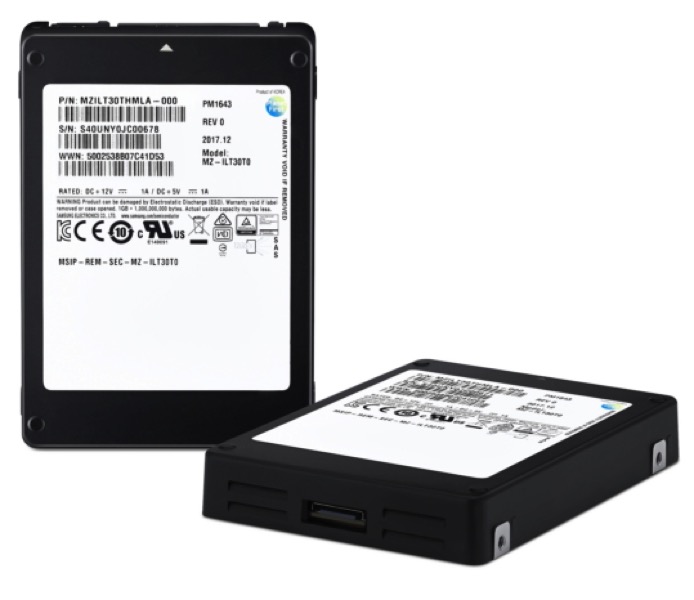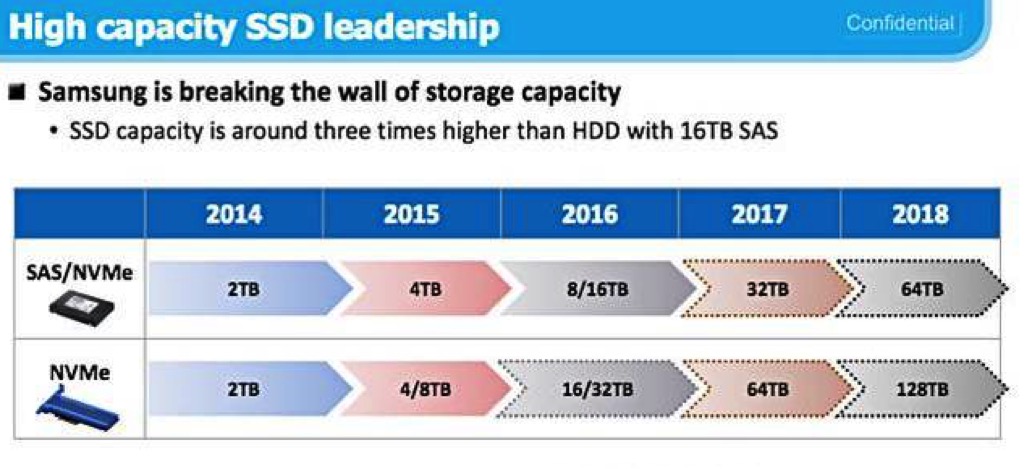Samsung Said to Mass Produce Industry Largest Capacity SSD: 30.72TB
2.5-inch, 512Gb V-NAND chip, 12Gb SAS, R/W up to 2,100MB/s and 1,700 MB/s
This is a Press Release edited by StorageNewsletter.com on February 21, 2018 at 2:27 pmSamsung Electronics Co. Ltd. begun mass producing the industry’s largest capacity SAS SSD, the PM1643, for use in next-generation enterprise storage systems.
Leveraging Samsung’s V-NAND technology with 64-layer, 3-bit 512Gb chips, the 30.72TB drive delivers twice the capacity and performance of the previous 15.36TB high-capacity lineup introduced in March 2016.
This breakthrough was made possible by combining 32 of the new 1TB NAND flash packages, each comprised of 16 stacked layers of 512Gb V-NAND chips. These dense 1TB packages allow for approximately 5,700 5GB, full HD movie files to be stored within a 2.5-inch storage device.
In addition to the doubled capacity, performance levels have risen and are nearly twice that of Samsung’s previous generation high-capacity SAS SSD. Based on a 12Gb SAS interface, the new PM1643 drive features random read and write speeds of up to 400,000 IO/s and 50,000 IO/s, and sequential read and write speeds of up to 2,100MB/s and 1,700 MB/s, respectively. These represent approximately four times the random read performance and three times the sequential read performance of a typical 2.5-inch SATA SSD*.
“With our launch of the 30.72TB SSD, we are once again shattering the enterprise storage capacity barrier, and in the process, opening up new horizons for ultra-high capacity storage systems worldwide,” said Jaesoo Han, EVP, memory sales and marketing team, Samsung. “Samsung will continue to move aggressively in meeting the shifting demand toward SSDs over 10TB and at the same time, accelerating adoption of our trail-blazing storage solutions in a new age of enterprise systems.”
The Korean company reached the new capacity and performance enhancements through several technology progressions in the design of its controller, DRAM packaging and associated software. Included in these advancements is an efficient controller architecture that integrates nine controllers from the previous high-capacity SSD lineup into a single package, enabling a greater amount of space within the SSD to be used for storage. The PM1643 drive also applies Through Silicon Via (TSV) technology to interconnect 8Gb DDR4 chips, creating 10 4GB TSV DRAM packages, totaling 40GB of DRAM. This marks the first time that TSV-applied DRAM has been used in an SSD.
Complementing the SSD’s hardware ingenuity is enhanced software that supports metadata protection as well as data retention and recovery from power failures, and an ECC algorithm to ensure reliability and minimal storage maintenance. Furthermore, the SSD provides endurance level of one full drive write per day (DWPD), which translates into writing 30.72TB of data every day over the five-year warranty period without failure. The PM1643 also offers MTBF of two million hours.
Samsung started manufacturing initial quantities of the 30.72TB SSDs in January and plans to expand the lineup later this year – with 15.36TB, 7.68TB, 3.84TB, 1.92TB, 960GB and 800GB versions – to further drive the growth of all-flash-arrays and accelerate the transition from HDDs to SSDs in the enterprise market. The range of models and improved performance will be pivotal in meeting the growing storage needs in a host of market segments, including the government, financial services, healthcare, education, oil and gas, pharmaceutical, social media, business services, retail and communications sectors.
* Compared to 2.5-inch Samsung SSD 850 EVO
Comments
30.72TB is not the highest capacity for a SAS SSD but it's a record in 2.5-inch form factor, here 15mm height.

This kind of unit beats largely the record of 2.5-inch HDD at only at 5TB up to now (Seagate BarraCuda 15mm high, 5,400rpm, 6Gb SATA, 5 disks, 10 heads.) and even 3.5-inch HDD culminating at 14TB at Toshiba and Western Digital.
The Samsung 30.72TB PM1643 was already revealed at Flash Memory Summit 2017 but is now in production.
At the former event in 2016, Seagate shows a monstrous 60TB SAS SSD but in 3.5-inch form and this unit was never was officially released just anticipated for "some time in 2017". The device was based on Micron 3D NAND with a controller manufactured by Taiwan Semiconductor, and the HDD maker said it will be able to increase the capacity to 100TB in the future. It's not a dream. If you can pack 30TB in 2.5-inch volume, 100TB is not a problem into 3.5-inch form factor. Samsung also expects that SSDs with more than 100TB of storage capacity will be available by 2020 thanks V-NAND technology. Toshiba presented at FMS event quad level cell technology to reach 100TB in the near future, according to the company.
Also at FMS 2016, Nimbus Data revealed a 4U ExaFlash C-series all-flash subsystem with a 3.5-inch removable SSDs at 50TB each, apparently from its own design.
On its side, Smart Modular introduced last year Osmium Drive, a 50TB 3.5-inch SAS SSD and Lenovo said it was just developing a 48TB device in the space of two 2.5-inch units including several SSDs, planned to be released by the middle of this year.
Last July 2017, Viking Technology claims to ship 6Gb SAS SSD at 50TB, the UHC-Silo, the same year Smart IOPS reached 26TB, NGD Systems 24TB in PCIe unit, and this year Novachips 24TB (see table below).
Very few companies are engaged into 3.5-inch SSDs. Several years ago this form factor was a popular volume for SSD to get the possibility to reach higher capacity at a time where the flash chips were much larger and 3.5-inch form factor popular in the industry. Few of today's storage subsystems or servers are able to accept 3.5-inch volume for drives, that's what we don't see a great future for these large devices and we doubt that other manufacturers will enter into 3.5-inch SSDs that is going to be a niche market.
But what about the prices? The costs of all the new high-capacity SSDs never were officially announced, just because they are very expansive. An example is CDW selling the Samsung 12Gb SAS 15.36TB PM1633A unit which shipped last March as high as $11,625! Twice more for the 30.72TB?
We don't see SSD - too expansive - becoming a storage media for cold data in the next future but high end SSDs will definitively kill enterprise 10,000 and 15,000rpm HDDs at 'only' 10TB, three times less. Expects to see all-flash systems to increase largely their capacity this year.
More than that Samsung expects to have a 64TB SSD as soon as this year as well as 128TB for PCIe flash unit.
Roadmap of Samsung's PCIe and SAS SSDs

Read also:
Flash Memory Summit: Toshiba Unveils Enterprise 2.5-Inch PM5 12Gb SAS and CM5 NVMe SSDs With 64 Layer TLC BiCS Flash
From 400GB to 30.72TB for PM5 12Gb SAS, and from 800GB to 15.36TB for CM5 NVMe SSDs models using 64 layer, 3-bit-per-cell enterprise TLC BiCS flash
2017.08.16 | Press Release
Flash Memory Summit: Smart Modular Introducing Osmium Drive, 50TB 3.5-Inch SAS SSD
2017.08.08 | Press Release
Monstrous 60TB SAS SSD by Seagate but in 3.5-Inch Form Factor
And 8TB Nytro XP7200 NVMe SSD
2016.08.11 | Press Release | [with our comments]
Samsung Enterprise 2.5-Inch SSD With Huge 15TB Shipping
Beating largely all HDDs at maximum 10TB in 3.5-inch form factor
2016.03.04 | Press Release
SSDs at 15TB and more revealed
| Announced in | Vendor | Model | Form factor | Capacity |
| 2016 | Seagate Technology | 60TB SAS SSD (never in production) |
3.5 inch | 60TB |
| 2017 | Viking Technology | UHC-Silo SAS SSD | 3.5 inch | 50TB |
| 2014 | Smart Modular | Osmium Drive | 3.5 inch | 50TB |
| 2016 | Samsung | PM1643 SAS SSD | 2.5 inch | 31TB |
| 2017 | Smart IOPS | Data Engine T2HC | HHHL AIC | 26TB |
| 2018 | Novachips | Scalar 270 | 2.5 inch | 24TB |
| 2017 | NGD Systems | Catalina | PCIe | 24TB |
| 2012 | OCZ Technology | Z-Drive R4 CloudServ | PCIe | 16TB |
| 2012 | OCZ Technology | Z-Drive R4 CloudServ RM1616 | 2.5 inch | 16TB |
| 2016 | Samsung | PM1633a | 2.5 inch | 15TB |
| 2017 | Seagate | Nytro 3000 SAS | 2.5 inch | 15TB |













 Subscribe to our free daily newsletter
Subscribe to our free daily newsletter

